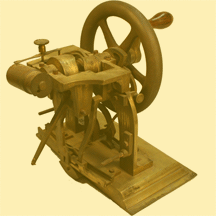How Did Elias Howe’S Sewing Machine Work: Unraveling Mechanics
Elias Howe was an inventor. He was born in 1819. He made one of the first sewing machines. His machine was special. It helped people sew faster. Let’s see how it worked.
The Problem Before Sewing Machines
Before sewing machines, people sewed by hand. Hand sewing took a long time. It was hard work. Clothes and other fabric items needed many hours. People wanted a faster way.
Elias Howe’s Big Idea
Elias Howe had a big idea. He wanted to make sewing faster. He thought about a machine. This machine could sew for people. It could do it faster than hands.
The Parts of the Sewing Machine
The sewing machine had different parts. Each part did something special. Let’s look at the main parts.
| Part | Function |
|---|---|
| Needle | Pierces the fabric |
| Thread | Makes the stitches |
| Bobbins | Holds extra thread |
| Shuttle | Passes thread through loops |
| Hand Crank | Makes the machine move |
Credit: www.asme.org
How the Machine Worked
The sewing machine was clever. The needle was important. It had a hole at the point. This was different from hand sewing needles. The needle moved up and down.
The thread went through the needle. The needle pierced the fabric. It made a loop with the thread.
The shuttle was under the fabric. It moved side to side. The shuttle carried thread. It passed through the loop made by the needle.
The two threads tied together. This made a stitch. The fabric moved forward. Then, the needle made a new stitch.
Why It Was Important
Elias Howe’s machine was important. It made sewing fast. People could sew more in less time. This was good for clothes makers. They could make clothes faster.
The machine was also good for factories. Factories made many clothes. The sewing machine helped them. It made work easier for workers.
The Impact on People
Many people liked the sewing machine. It saved time. It saved energy. People could sew at home. They could sew for their families.
Clothes became cheaper. More people could buy them. The sewing machine changed how people worked. It changed how they dressed.

Credit: historycambridge.org
Challenges Elias Faced
Elias faced challenges. Some people did not believe in his machine. He had to prove it worked. He also needed money. Money to make and sell the machines.
He went to court. He fought for his rights. He won his case. People started to use his machine.
Legacy of Elias Howe
Elias Howe left a big mark. His machine helped many people. It was a step forward. Other inventors improved it. Sewing machines today are much better.
Frequently Asked Questions
What Was Unique About Elias Howe’s Sewing Machine?
Elias Howe’s machine used a lockstitch system with a needle and shuttle. This design was new and efficient.
How Did The Needle Work In Howe’s Machine?
The needle moved up and down, creating stitches by interlocking thread with a shuttle. This made strong seams.
Did Elias Howe’s Machine Use A Foot Pedal?
Yes, it did. The foot pedal powered the machine, making sewing easier and faster than manual methods.
What Materials Could Howe’s Sewing Machine Handle?
It could sew various fabrics, including cotton and wool. This versatility made it useful for many garments.
Conclusion
Elias Howe’s sewing machine was a smart invention. It showed how machines could help people. It made sewing easier and faster. It helped many people. This invention is still important today.
Understanding how it worked is simple. The needle, thread, and shuttle worked together. They made stitches fast. This simple machine changed lives. It showed the power of ideas.

![What Is The Best Beginner Sewing Machine for Denim [In 2025]](https://homeunderstandable.com/wp-content/uploads/2025/07/best-beginner-sewing-machine-for-denim.jpg)

![5 Best Black Friday Sewing Machine Deals [In 2025]](https://homeunderstandable.com/wp-content/uploads/2025/07/best-black-friday-sewing-machine-deals-unbeatable-offers-on-top-models-768x576.jpg)
![5 Best Brand Sewing Machine for Beginners [In 2025]](https://homeunderstandable.com/wp-content/uploads/2025/07/best-brand-sewing-machine-for-beginners-top-picks-for-easy-stitching-768x512.jpg)
![What Is The Best Beginner Intermediate Sewing Machine [In 2025]](https://homeunderstandable.com/wp-content/uploads/2025/07/best-beginner-intermediate-sewing-machine.jpg)